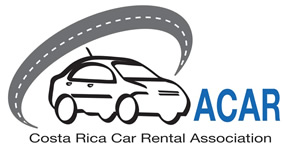Old-blog posts
Welcome to our Blog
Blog Posts
ACAR members — Adobe, Mapache and Toyota car rental agencies — were invited to represent the industry in the launch of the Unforgettable Costa Rica campaign’s code of conduct.
‘Child sexual exploitation is an unacceptable practice that we must tackle comprehensively. This is a crime for which there are severe prison sentences. The ‘Unforgettable Costa Rica’ initiative is a positive move …to combat this issue.’ Ana Helena Chacon, Vice President of Costa Rica
Costa Rica’s Ministry of Tourism and the PANIAMOR Foundation have joined forced in a new, powerful campaign aimed to publicize the country’s strict laws to protect children under the age of 18 from sexual exploitation. Using a website with a format common to those used in the tourism industry, the Unforgettable Costa Rica page shows images of the inside of a prison in the mock advertisement for free accommodation for tourists looking for young girls while on vacation.
Links to the website have been provided by fake account users on sites that deal with sexual tourism to push potential offenders to the Unforgettable page, where information about the user’s country of origin is saved. The statistical data collected will be invaluable in the continued fight against the rise of sexual tourism through websites and social media.
While prostitution is legal in Costa Rica, the promotion of the country as a sex tourism destination is strongly discouraged due to the threat to underage girls. It’s hoped that the stark images of the jail interior, in sharp contrast to the website’s appealing homepage, will be an effective deterrent to sex predators.
The 450 local businesses invited to participate in last week’s launch are committed to continue to spread awareness by promoting the link to Unforgettable Costa Rica on their websites and in their interactions with clients. The Costa Rican Car Rental Association (ACAR) are one of the organizations involved in the tourism industry in the country eager to protect the rights of young people through this invaluable campaign.
‘I’m a member of the Code of Conduct Assessor Program committee and represent ACAR. For the rent a car agencies, it is part of our work as responsible businesses. It is another commitment, a conviction to do things well and to protect girls, boys and adolescents from whatever type of abuse.’ said Jackelin Lopez Cordero, Mapache Rent a Car.
Costa Rica will keep promoting itself as a destination to relax and unwind as part of its Save the Americans publicity campaign to bring North American tourists to the country in search of nature and a stress-free environment, while continuing to protect the most vulnerable members of its population from unwanted guests.
See the whole page at: http://unforgettablecostarica.com/en/
Posted: November 3rd, 2015
Car Insurance Made Easy
One of the confusing parts of car rental for many visitors to Costa Rica is the mandatory insurance requirement so let’s clarify that right now.
Third Party Insurance (TPI) is a government imposed requirement for all car rental in Costa Rica, as it is in other countries in the world, including Ireland, New Zealand, Australia, Italy and Slovenia. This insurance may also be referred to as Supplementary Liability Insurance (SLI) or Additional Liability Insurance (ALI).
The insurance price is not set, and can vary depending on the car category rented. The daily fee is usually between $12 and $25, but each car rental agency sets their price.
Credit card coverage doesn’t include the third party insurance requirement and it must be purchased.
Most car rental agencies do not include third party insurance in their advertised prices. Check the daily rate listed for this additional cost and check that it is included in the breakdown of costs received in your quote.
Collision Damage Waiver (CDW) or Loss Damage Waiver (LDW) Is NOT insurance. CDW is frequently a perk offered by credit card providers, and is not a compulsory coverage for car rental, if the renter can provide written proof of this coverage. While most Americans and Canadians are familiar with this perk; credit card providers in other parts of the world are not usually covered and will need to buy CDW in order to rent a vehicle.
This coverage comes with a deductible that is usually about $1,000.
Zero Deductible Collision Damage Waiver is the ticket to complete peace of mind. There is no deductible and so any damage to the vehicle (see exclusions to this below) is not the renter’s financial responsibility.
Windscreen or Tire coverage is offered by a number of car rental agencies as an additional coverage as these items are not covered by the regular CDW, due to damage to the windscreen or tires frequently occurred when the driver doesn’t exercise due caution. This is a minimal daily fee.
Points to be aware of when using credit card coverage for the CDW:
• The deposit on the rental vehicle will be higher if credit card coverage is chosen over in-house coverage. This may depend on the car category being rented but will be around $2,000 to $5,000.
• Renters are responsible for submitting claims should this be necessary. In-house CDW puts the responsibility onto the car rental agency to submit and follow through the claim.
• The car category or vehicle type is covered by the credit card. Vans larger than an eight-seater aren’t covered by major credit cards, but some also decline coverage for full size SUVS. Renters will need to purchase in-house CDW to rent these vehicle categories.
• Car rental duration. Usually the credit card coverage applies for a limited time period; frequently that period is 30 days or less. Renters that require a longer term rental will need to begin a new rental contract in order to continue using the credit card coverage.
And it’s that simple! You must pay for Third Party insurance. You have to provide proof of CDW coverage or purchase this from the car rental agency. Ask the car rental agency for the final price of your rental with all fees, surcharges and taxes included. Do read the small print to be sure that your credit card provider does cover your vehicle, length of rental and you’re prepared to do the legwork if a claim needs making. Now you can relax and enjoy the drive!
Driving in Costa Rica
Much like any other city driving in the world, Costa Rica’s cities are busy and traffic holdups are frequent with impatient drivers honking their horns at a millisecond’s delay at the lights. However, most visitors don’t spend their vacation fighting peak hour traffic and leave the relatively small cities of Liberia and San Jose to head out to the mountains, beaches and volcanoes that have brought them to Costa Rica. Road conditions vary across the country but are constantly improving – although the nation retains its poor reputation for infrastructure.
Extreme weather conditions from drought to flooding, mean that road surface wear and tear is considerable and so repairs are frequent, but not always adequate. Major routes are generally well maintained but less travelled roads may be unpaved, one lane and/or potholed.
Mountain driving
Driving over mountains is necessary to get just about anywhere outside of the Central Valley, where the capital city is located, and while the views are spectacular, caution is advised. Route 32 and the southern Pan-American Highway are characterized by frequent bends, occasional torrential downpours and mist, and large trucks. Here are a few tips to driving the mountains:
• Don’t ride the brakes. Overheating the brake pads can lessen brake efficiency.
• Stay patient. Being stuck behind a large truck can be tedious but overtaking on mountainous bends is ill-advised.
• Use low beams on headlights if road is foggy. Pull over and wait if fog or rain makes visibility difficult.
Rural driving
Once out of the city or the Central Valley region, main highways across the country are generally in good condition and easily navigable. Smaller roads may be slower to drive. Points for driving in the countryside:
• Bridges are often one lane and signposting will indicate which side has priority for crossing.
• Sticks in the middle of the road are used to show where large holes are located. Drive around these with care.
• Stay alert for animals, cyclists and pedestrians as few rural roads have sidewalk.
Driving through rivers or onto beaches
Don’t. Despite the temptation of driving through the river in the middle of the road you’re driving on, resist and find another dry road with which to reach your destination. Driving into rivers, estuaries or other water will void car rental insurance. Driving onto the beach is equally a reason for insurance voiding, and despite the local vehicles that may be on the beaches; it is against the law.
Driving at night
Don’t. Long journeys that begin or will involve ending the journey after dusk are not recommended. Roads are not always well-lit and are used by both pedestrians and cyclists, which can be concerning in the dark. Sunset is between 5:30 and 6:00 nightly. Visitors arriving on late flights should stay overnight in a hotel near the airport and either collect the rental vehicle in the morning or have it delivered to the hotel.
Obviously, driving from your vacation rental or hotel to a nearby restaurant and back is completely different and not advised against at all.
Finding your way around
Costa Rica has no formal address system and signage is often absent from roads, which can make finding places a challenge for the visitor. There are very few ‘normal’ addresses. Your hotel may be located ‘500 meters south of Super Mas o Menos, 200 meters west and has a wooden gate to enter’, for example. If you are lucky, the landmark that is used as the starting point for directions still exist! Many directions in the San Pedro neighbourhood of San Jose were given from a mango tree long after it had been cut down!
In San Jose, the city is carefully mapped out in a grid system with ‘calles’ (roads) running north-south, and ‘avenidas’ (avenues) running from east-west.
The easiest way to ensure that you’re on the right road is to rent a GPS system with your rental vehicle. Simply program the GPS coordinates of your destinations into the system and follow the directions given.
A paper map is useful for journey planning and to see the route ahead. Ask your car rental agency if they provide a free map for your use.
Some visitors use smartphones for online maps. These devices can be very helpful but do bear in mind that in the most rural and isolated places, the internet signal may be very weak or non-existent just as you need a map most!
Waze is quickly growing in popularity, especially in the cities. Google maps have many details but journey times tend to be underestimated. Yourtravelmap.com is a useful tool for driving times and Costa Rican style directions.
Helpful hints for directions:
• Use landmarks. Even if roads are numbered, locals will generally use nearby landmarks rather than road numbers to give directions.
• One hundred meters is equal to a block. If you’re told to drive three hundred meters before turning left, just count the blocks.
• Most towns are built around the Catholic church and square. The church entrance almost always faces west.
Road conditions in Green season
From May to December, Costa Rica is in green season. Steady afternoon showers affect road conditions all over the country, and drivers need to adapt to these:
• Plan journeys for the morning to avoid driving in the rain.
• Be prepared to pull over if visibility is impaired due to rain.
• Keep updated with road conditions. Heavy rains can cause routes to be closed or traffic regulated if landslides occur.
• Watch out for puddles which may hide a large hole.
• Be advised that in heavy rains, drain covers can be pushed up into the road by the force of water.
Roads to Watch
The roads listed below are those most widely travelled by visitors to Costa Rica and not a comprehensive list of routes that may challenge the new driver in the country. It is safe to assume that the further off the beaten track driven, the less developed the road will be!
Route 27 aka Autopista Del Sol was welcomed as a fast, modern road joining the capital city to the Central Pacific coast. Journey time is substantially less than on the old route, but there have been issues with the standard of construction and some lane closures for periods of time due to landslides. National holidays and peak vacation times see heavy traffic on this route and the administrators often enforce lane reversibility to cope with the traffic returning to the Central Valley from the coast. Those traveling to the Pacific during these scheduled one way routings, should take the old road via Atenas and Orotina.
Route 32 is the highway between San Jose and the port city of Limon on the Caribbean coast. During heavy rain, the mountainous first leg of this road may be closed due to landslides or as a precautionary measure if authorities are concerned that landslides could occur imminently. An alternate route is available via Cartago and Turrialba if the road is closed.
Route 606 to Monteverde is one of the most well-known roads in the country for all the wrong reasons. Rugged and on a steep incline, it is best tackled in an SUV for the higher clearance offered. The views are spectacular and as the journey is sloooow; there is plenty of time to admire them. Improvements are promised on this fairly busy route, although locals are nervous that easier accessibility may lead to too many visitors entering the very delicate cloud forest environment.
Route 142 around Lake Arenal is a scenic drive but has had issues in recent years with flooding during and after heavy rainfall. Use caution.
Pan-American Highway south from the capital, San Jose down to the south Pacific and Panamanian border has a mountainous stretch which needs to be driven with care. This region is a birdspotter’s paradise as the habitat of the shy Quetzal, but the driver will need full attention on the road.
Guanacaste and Nicoya coastal area has some of the country’s most beautiful beaches, but part of their charm is that they are relatively undiscovered due to the poor condition of the roads leading to them. During green season especially, much of the region is only accessible by SUV and some routes may require a 4×4. A number of roads are best avoided altogether once the rains begin as the rivers crossing them will fill.
Child Seating
Traveling with children? Check through our guidelines for the child seating regulations in place according to Costa Rican law—you may be surprised!
Make sure that your car rental agency is aware of the children in your party that require seating. Car rental agencies provide child and booster seats, usually at a daily fee, but these should be reserved at the time of rental confirmation, especially if arriving in high season.
| Child seating regulations based on age, weight and height | ||||
| Type of Seat | Group | Age | Weight | Height |
| Baby seat | 0* | 0 months to one year | Less than 10 kg/22 lbs. | Up to 75 cm/2.5 feet. |
| 0+ | Less than 13 kg/29 lbs. | |||
| Child seat | I | 1-4 years | Between 9 and 18 kg/20 and 40 lbs. | Between 75 and 110 cm/2.5 and 3.6 feet. |
| Booster seat (with back) | II | 4-6 years | Between 15 and 25 kg/33 and 55 lbs. | Between 110 and 145 cm/3.6 feet and 4.8 feet. |
| Booster | III | 6-12 years | Between 22 and 36 kg/49 and 79 lbs. | |
*0 is the smallest size but isn’t frequently used, as the 0+ is also rear-facing but can be used until the infant is older and heavier.
Calculating the correct child seat is based on three factors: age, height and weight of the child. This may appear confusing but the Ministry of Transport and Public Works confirms that the most important of these is the height of the child. Regulations stipulate that to travel without any type of seating, the child must be tall enough for their feet to touch the floor of the vehicle and for the seat belt to secure across the chest.
The following examples should clarify how to use the chart above:
| Age | Weight | Height | Type of seating |
| 13 months | 29 lbs | 2.3 feet | Baby seat |
| 10 years | 63 lbs | 5 feet | No child seating required |
| 5 years | 45 lbs | 4 feet | Booster with back |
| 3 years | 36 lbs | 3.4 feet | Child seat |
Note that child seating cannot be used in the front seat of a vehicle. A child may only sit in the front passenger seat at the age of 12 or older.
Seat placement
There are clear legal guidelines for the organization of child seating. The baby seat should be fitted into the center of the back seat. A child seat should be fitted behind the passenger seat, and in the case of three children, the biggest child should have their seating fitted behind the driver.
Bring your own child seating
Airlines permit that customers travel with child seating, although this is obviously bulky. Check that the child seating used by your children in your home country conforms to Costa Rican regulations.
There are a number of factors to consider in order to select the most suitable vehicle for your Costa Rican driving.
Location and destinations
Generally speaking, visitors that intend to remain in the Central Valley or to travel destinations with a well-developed roads, such as Jacó, can rent a sedan. For anywhere else in the country, an SUV is usually recommended. There may be some hotels or places of interest that require a robust 4×4, such as Santa Rosa National Park in Guanacaste, but mostly visitors are more comfortable driving a vehicle with higher clearance than a sedan can offer.
Season
During green season, an SUV is more useful for traveling the country and the bonus is that as these months are low season, it’s likely that rental prices are lower than other times of the year.
Credit Card CDW
Check that fine print with a magnifying glass! Renting a vehicle with more than 8 seats usually is not covered by the credit card provider and different cards offer different terms; some exclude CDW coverage on larger or premium SUVS, so be sure that the terms of coverage apply to the car category rented to reap the benefits of this free perk.
Number of passengers and luggage
Long, hot car journeys can be tiring enough, but nothing is worse than being squashed into the seat by other members of the family or group too! Check the description and vehicle type offered in the car category before making the reservation. Points to consider:
- A child seat is bulky and will take up as much room as an adult passenger.
- For extra luggage or surfboards consider a luggage rack.
- Weigh up price against comfort—often the next car category up is not a huge price leap.
Car categories
Do read which make(s) and model(s) are listed in each car category. Frequently, Costa Rican car categories differ from North American ones and what constitutes ‘full-sized’ at home may not be the same here. Typical car makes/models and car categories are listed below:
Economic sedan Nissan Tiida, BYD FO, Nissan Celerio
Compact/mini sedan Toyota Yaris, Hyundi Accent Blue, Nissan Sentra, Suzuki Alto
Standard sedan Toyota Corolla, Nissan Versa, Kia Cerato, Hyundi Elantra
Mini SUV Suzuki SX4
Compact/small SUV Suzuki Jimny, Dahiutsu Bego, Dahitsu Terios
Intermediate SUV Dahitsu Bego
Standard SUV Suzuki Grand Vitara, Nissan X-trail, Hyundi Tucson
Mitsubushi Montero
Full size SUV Toyota Prado, Nissan Xtrail, Mitsubishi Nativa
Premium/Luxury SUV Nissan Pathfinder, Toyota Prado, Sequio, Hyundai Santa Fe, Toyota Landcruiser
Minivan Mitsubishi Zinger
Van Hyundai H1, Nissan Urvan, Jac Refine
Hybrid vehicles
These are available but not in common use.




Leave a Reply